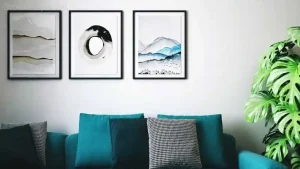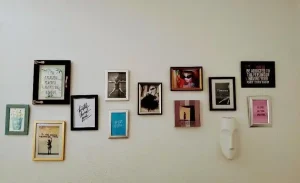A gallery wall can transform a space, adding personality, color, and emotional depth to any room. Whether you’re decorating a living room, hallway, or even a bedroom, a well-curated gallery wall can serve as a focal point, evoke memories, or reflect your personal style. If you’re thinking about creating your own gallery wall, this guide will walk you through everything you need to know—based on reliable research, expert advice, and real-world insights.
1. The Basics of a Gallery Wall
A gallery wall is a collection of artworks, photos, and decorative pieces arranged on a single wall. The beauty of a gallery wall lies in its versatility—you can mix frames of different sizes, colors, and styles to create a dynamic and personalized display. Some people focus on symmetry, while others lean into a more eclectic or “collected over time” feel.
Why Create a Gallery Wall?
The impact of a gallery wall goes beyond aesthetics. Research in environmental psychology highlights that the way we arrange art can affect our mood and emotional well-being. A thoughtfully designed gallery wall can make a space feel more intimate, cozy, or energizing, depending on the artwork chosen.
Moreover, studies suggest that visual stimuli like art can stimulate creativity, enhance cognitive function, and even reduce stress. According to a 2017 study published in the Psychology of Aesthetics, Creativity, and the Arts, exposure to art in a home environment can increase feelings of well-being and satisfaction, creating a calming influence in the home.
2. Choosing the Right Space
Before you start collecting artwork, it’s important to choose the right wall. Some common places for gallery walls include:
- Living rooms: Typically the most spacious room in the house, ideal for large displays.
- Hallways: Narrow spaces benefit from vertical arrangements or a series of smaller pieces.
- Bedrooms: A gallery wall can create a personal and relaxing atmosphere.
- Staircases: A great location for a dynamic vertical display, where you can create a narrative as you ascend.
Make sure the wall you choose complements the rest of the room. Measure the wall space to ensure your collection fits comfortably without overcrowding.
3. Selecting Artwork for Your Gallery Wall
There’s no one-size-fits-all when it comes to art selection for a gallery wall. Your choices should reflect your tastes, the room’s aesthetic, and the mood you want to create. Here are some tips based on what experts and psychologists say about art in the home:
Art Styles
- Traditional vs. Modern: If your home has a more classic feel, traditional art pieces or vintage photographs may work best. On the other hand, a more contemporary room might be suited for abstract art, geometric designs, or even modern photography.
- Personal vs. Decorative: Some people prefer to feature personal photos, while others opt for decorative art prints. Both choices can serve different purposes—personal photographs evoke nostalgia and emotion, while decorative prints can add color and style.

Theme
Themes can tie your gallery wall together. These can be literal (e.g., travel photography, family portraits) or abstract (e.g., a color palette or a series of nature-inspired prints). Studies on visual cognition suggest that people are drawn to cohesive themes because they make a space feel harmonious.
Frames and Sizes
Mixing frames in various colors and styles can add visual interest, but be mindful of balancing them to avoid a cluttered look. If you’re working with a limited budget, thrift stores and online marketplaces are great sources for affordable frames. You don’t have to spend a fortune to create a beautiful display.
In terms of size, the largest piece should be placed centrally or at eye level to create a focal point. Then, fill in the space with smaller works, ensuring that they relate to the central piece in terms of color, style, or theme.
4. The Layout: How to Arrange Your Gallery Wall
One of the most challenging parts of creating a gallery wall is arranging the artwork. There’s no “perfect” layout, but there are strategies you can use to ensure a pleasing composition:
- Grid-style layout: This method involves aligning all frames along the edges, creating a clean, uniform grid. It’s great for those who appreciate symmetry and order.
- Salon-style layout: Popular in art museums, this approach uses multiple pieces in various sizes arranged closely together, often from floor to ceiling. It’s ideal if you have a lot of artwork to display and prefer a more dynamic look.
- Linear layout: This involves placing all pieces in a single line, either horizontally or vertically. It’s a good option if you have limited space or want a more minimalist feel.
To visualize the layout before you commit, use painter’s tape on the wall to outline where each piece will go. This will help you adjust spacing and positioning easily.
5. Hanging Your Gallery Wall
Once you have your layout figured out, it’s time to hang the artwork. Here are a few things to consider:
- Spacing: Maintain consistent spacing between pieces, whether that’s 2-3 inches for a grid layout or more flexible spacing for a salon-style arrangement. Too much space between pieces can make the wall feel disjointed, while too little can create visual clutter.
- Eye level: Generally, artworks should be hung so that the center of each piece is at eye level. However, this can vary based on the height of the people in the household or the size of the wall.
- Tools: Invest in good picture-hanging hardware. Heavy-duty picture hooks are ideal for large frames, while adhesive strips or wire can work for smaller pieces or lightweight frames.

6. Maintenance and Adjustments
Gallery walls are not static—over time, you may want to update your collection to reflect new interests or experiences. Don’t hesitate to swap out pieces, adjust the layout, or change the framing style to keep things fresh. Also, consider rotating artwork seasonally or to mark special occasions—this keeps your space feeling dynamic and interesting.
7. Common Pitfalls and How to Avoid Them
No design project is without its challenges, and creating a gallery wall is no exception. Here are some common mistakes and how to avoid them:
- Overcrowding the wall: This is a common mistake, especially for those who want to display as much as possible. A crowded gallery wall can feel overwhelming and chaotic. Stick to a few key pieces and leave some breathing room for each one.
- Neglecting the room’s style: A gallery wall should complement the existing decor. Avoid mixing art styles that clash with the room’s overall aesthetic. For instance, traditional art may feel out of place in a modern industrial loft.
- Ignoring lighting: The right lighting can elevate your gallery wall. Consider using adjustable picture lights or spotlights to highlight your pieces. If natural light is available, use it to your advantage—but be mindful of fading.
8. Real-World Opinions on Gallery Walls
Here are some insights from a diverse range of people about their experiences with gallery walls:
- Alex (30s, New York, USA): “I created a gallery wall in my apartment with a mix of black-and-white photography and some contemporary art pieces. It gives the room an urban, creative vibe. I also love that I can swap out pieces over time, so it feels like the wall is constantly evolving.”
- Lena (50s, Berlin, Germany): “In my living room, I’ve combined personal family portraits with a few travel photos. I made sure to stick with warm tones to match my wood furniture. The key was finding the right balance between personal memories and just beautiful art. It’s now the focal point of the room.”
- Keiko (40s, Tokyo, Japan): “I wanted a minimalist look, so I created a very simple gallery wall with just three pieces—large abstract art with similar colors. It’s simple but powerful. It really helps set a peaceful atmosphere in my home.”
- Carlos (60s, Buenos Aires, Argentina): “I’ve never been one for symmetrical galleries, so I created a salon-style wall with a variety of sizes and styles—artwork, photos, and even a vintage mirror. It’s a conversation starter, and my guests love it.”
- Maria (70s, Cape Town, South Africa): “I filled my gallery wall with local art from South African artists. It’s a personal project, and every piece has a story. My advice? Don’t rush it—take your time collecting pieces that truly resonate with you.”
Conclusion
A gallery wall can add warmth, personality, and beauty to any room, and with a little planning, you can create a display that’s both visually stunning and deeply meaningful. Whether you prefer a minimalist layout or a dynamic, salon-style wall, there’s no wrong way to create a gallery that reflects your tastes. Just remember to take your time, plan carefully, and enjoy the process—it’s your space, after all!









